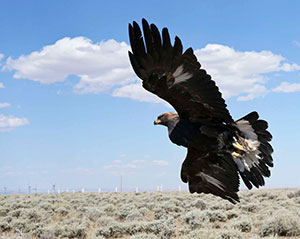Tool Released to Identify Key Habitats for Golden Eagles in Wyoming
Published November 28, 2023

While bald eagles are one of the best conservation success stories in the United States, golden eagle populations continue to struggle in the West. Scientists at the University of Wyoming and elsewhere working to help eagles have identified key eagle habitats and created a free, online tool to help direct conservation efforts.
Teton Raptor Center has announced the official launch of RaptorMapper.com, which maps critical habitats and calculates the conservation values of land parcels for golden eagles across Wyoming.
Golden eagles are of significant conservation concern due to increasing threats to their populations from factors such as increasing wind energy development, lead poisoning, habitat loss and declining prey populations.
Wyoming is a key area for nesting golden eagles in the West. Additionally, the state has some of the best wintering habitat and important migration corridors for golden eagles that spend the breeding season in Canada and Alaska. The state also has some of the best wind resources and fastest-growing renewable wind energy development in the country.
“Being able to identify and calculate the value of any area of the state for golden eagles is critical to maintaining their populations for future generations,” says Bryan Bedrosian, team leader for the highly collaborative RaptorMapper project, conservation director for Teton Raptor Center and an adjunct senior scientist with UW’s Wyoming Natural Diversity Database.
Bedrosian worked closely with colleagues from Cal Poly-Humboldt, the Wyoming Natural Diversity Database, Natural Resource Geospatial and Gage Cartographics for the past three years to develop models and maps of crucial golden eagle habitat across Wyoming and the surrounding regions. Using thousands of nesting records and tens of millions of locations collected from tagged golden eagles by many biologists from across the country, the team has identified previously undescribed important seasonal habitats for the species.
The RaptorMapper team sought to create an open-source conservation tool, so it developed a free, online mapping tool to explore the maps and also calculate the value of any user-defined parcel of land for eagles.
“Developers, biologists and landowners can all evaluate how important any area is to golden eagles,” says Jeff Dunk, a professor at Cal Poly-Humboldt and a key member of the research team. “For example, RaptorMapper.com shows the highest 20 percent of nesting territories are located within only 5 percent of Wyoming, while the lowest 20 percent occur across 50 percent of the state. Using these maps to direct conservation actions in those limited areas of high value will have much greater impact to the population. Now that we have developed the methods to map these habitats at large scales, we are excited to work with new partners to expand this tool to other states and species in the future.”
In recent years, the overlap of golden eagle habitat and wind energy development in Wyoming has led to several major utility companies being prosecuted for eagle fatalities at wind farms -- and an increase in the number of eagle take permit applications with the U.S. Fish and Wildlife Service. Permits also include direct payments for conservation actions to offset any eagle deaths.
“RaptorMapper can be used by utility companies to assess risk in initial project planning to avoid costly eagle fatalities and, at the same time, help direct those mitigation dollars to areas that will have the greatest benefit to eagles,” Bedrosian says.
“This type of information is important to guide management of sensitive species, like golden eagles, in Wyoming,” says Zach Wallace, Wyoming Game and Fish Department nongame bird biologist, who also is lead author of one of the scientific journal articles that provides the basis of this work. “Everyone now has access to consistent, scientifically defensible data to proactively avoid potential impacts to eagle populations across the state.”
Wallace conducted the research in his former role as a biologist for UW’s Wyoming Natural Diversity Database.
RaptorMapper is available on any web platform, along with the ability to download the maps, reports, detailed information on the study and user guides for the tool.
Funding for the study and tool was provided by the Knobloch Family Foundation and Teton Raptor Center. The Knobloch Family Foundation is committed to investments that ensure the conservation of natural ecosystems, and Teton Raptor Center is a nonprofit organization in Wilson whose mission is to advance raptor conservation through education, research and rehabilitation.
Data used in this project were provided by dozens of biologists, organizations and agencies from across the West.

